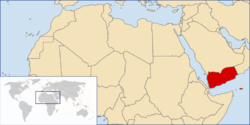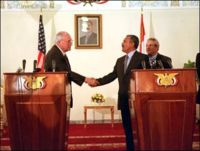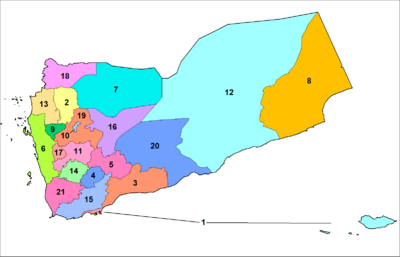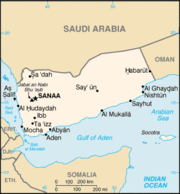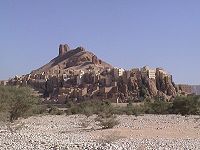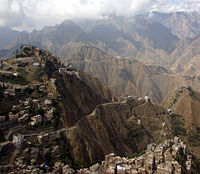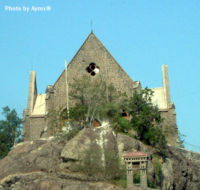Yemen
2008/9 Schools Wikipedia Selection. Related subjects: Middle Eastern Countries
| الجمهورية اليمنية Al-Jumhūriyyah al-Yamaniyyah Republic of Yemen
|
||||||
|---|---|---|---|---|---|---|
|
||||||
| Motto: "Allah, al-Watan, at-Thawra, al-Wehda" "God, Nation, Revolution, Unity" |
||||||
| Anthem: United Republic |
||||||
|
|
||||||
| Capital (and largest city) |
San‘a’ |
|||||
| Official languages | Arabic | |||||
| Demonym | Yemeni, Yemenite | |||||
| Government | Republic | |||||
| - | President | Ali Abdullah Saleh | ||||
| - | Prime Minister | Ali Mohammed Mujur | ||||
| Establishment | ||||||
| - | Unification | May 22, 1990 | ||||
| Area | ||||||
| - | Total | 527,968 km² ( 49th) 203,849 sq mi |
||||
| - | Water (%) | negligible | ||||
| Population | ||||||
| - | July 2008 estimate | 23,013,376 ( 51st) | ||||
| - | July 2007 census | 22,230,531 | ||||
| - | Density | 42/km² ( 160th) 109/sq mi |
||||
| GDP ( PPP) | 2007 estimate | |||||
| - | Total | $52.61 billion ( 81st) | ||||
| - | Per capita | $2,400 (2007 est.) ( 132nd) | ||||
| HDI (2007) | ▲ 0.508 (medium) ( 153rd) | |||||
| Currency | Yemeni rial $1 = 198.13 Rials ( YER) |
|||||
| Time zone | ( UTC+3) | |||||
| Internet TLD | .ye | |||||
| Calling code | +967 | |||||
Yemen (Arabic: اليَمَن al-Yaman), officially the Republic of Yemen (Arabic: الجمهورية اليمنية al-Jumhuuriyya al-Yamaniyya) is a Middle Eastern country located on the Arabian Peninsula in Southwest Asia. With a population of more than 20 million people, Yemen is bordered by Saudi Arabia to the North, the Red Sea to the West, the Arabian Sea and Gulf of Aden to the South, and Oman to the east. Yemen's territory includes over 200 islands, the largest of which is Socotra, about 415 kilometres (259 miles) to the south of Yemen, off the coast of Somalia. Yemen is the only republic on the Arabian Peninsula.
History
The land of Yemen is one of the oldest centers of civilization in the world. Between 2300 BC and the sixth century AD, it was part of the Sabaean, Awsanian, Minaean, Qatabanian, Hadhramawtian, Himyarite, and some other kingdoms, which controlled the lucrative spice trade. It was known to the ancient Romans as Arabia Felix ("Happy Arabia") because of the riches its trade generated. Augustus Caesar attempted to annex it, but the expedition failed. The Ethiopian Kingdom of Aksum annexed it by around 520, and it was subsequently taken by the Sassanids Persians around 570.
In the 3rd century and again in the late sixth and early seventh century, many Sabaean and Himyarite people migrated out of the land of Yemen following the destructions of the Ma'rib Dam (sadd Ma'rib) and migrated to North Africa and the northern part of the Arabian Peninsula. In the 7th century, Islamic caliphs began to exert control over the area. After the caliphate broke up, the former North Yemen came under the control of imams of various dynasties usually of the Zaidi sect, who established a theocratic political structure that survived until modern times. Egyptian Sunni caliphs occupied much of North Yemen throughout the eleventh century. By the sixteenth century and again in the nineteenth century, north Yemen was part of the Ottoman Empire, and during several periods its imams exerted control over south Yemen.
In 1839, the British occupied the port of Aden and established it as a colony in September of that year. They also set up a zone of loose alliances (known as protectorates) around Aden to act as a protective buffer. North Yemen became independent of the Ottoman Empire in 1918 and became a republic in 1962. In 1967, the British withdrew and gave back Aden to Yemen due to the extreme pressure of battles with the North and its Egyptian allies. After the British withdrawal, this area became known as South Yemen. The two countries were formally united as the Republic of Yemen on May 22, 1990.
Politics
Yemen is a republic with a bicameral legislature. Under the constitution, an elected president, an elected 301-seat House of Representatives, and an appointed 111-member Shura Council share power. The president is head of state, and the prime minister is head of government. The constitution provides that the president be elected by popular vote from at least two candidates endorsed by at least fifteen members of the Parliament. The prime minister, in turn, is appointed by the president and must be approved by two thirds of the Parliament. The presidential term of office is seven years, and the parliamentary term of elected office is six years. Suffrage is universal for people age 18 and older.
President Ali Abdullah Saleh became the first elected President in reunified Yemen in 1999 (though he had been President of unified Yemen since 1990 and President of North Yemen since 1978). After an initial reluctance to run once more, he was re-elected to office in September of 2006. Saleh's victory was marked by an election that international observers judged to be generally "free and fair". Popular demonstrations and editorials of support in major papers helped change his mind to run again. In April 2003, parliamentary elections were held, and the General People's Congress (GPC) maintained an absolute majority. There was a marked decrease from previous years in election-related violence. However, there were some problems with underage voting, confiscation of ballot boxes, voter intimidation, and election-related violence.
The constitution calls for an independent judiciary. The former northern and southern legal codes have been unified. The legal system includes separate commercial courts and a Supreme Court based in Sana'a. Since the country is an Islamic state, the Islamic Law (Sharia) is the main source for laws. Indeed, many court cases are debated by the religious basis of the laws. For this reason, many judges are religious scholars as well as legal authorities. Unlike Saudi Arabia and other Islamic states, however, the consumption of alcohol by non-Muslims is tolerated, and the mild stimulant qat is chewed by Yemenis of all strata of society, despite being banned or frowned upon by other Muslim countries and groups.
Governorates and districts
As of February 2004, Yemen is divided into twenty governorates ( muhafazah) and one municipality. The population of each governorate is listed in the table below.
| Division | Capital City | Pop (2004) | Key |
|---|---|---|---|
| 'Adan | Aden | 589,419 | 1 |
| 'Amran | 'Amran | 877,786 | 2 |
| Abyan | Zinjibar | 433,819 | 3 |
| Ad Dali | 470,564 | 4 | |
| Al Bayda' | Al Bayda | 577,369 | 5 |
| Al Hudaydah | Al Hudaydah | 2,157,552 | 6 |
| Al Jawf | Al Jawf | 443,797 | 7 |
| Al Mahrah | Al Ghaydah | 88,594 | 8 |
| Al Mahwit | Al Mahwit | 494,557 | 9 |
| Amanat Al Asimah | Sanaa | 1,747,834 | 10 |
| Dhamar | Dhamar | 1,330,108 | 11 |
| Hadramaut | Al Mukalla | 1,028,556 | 12 |
| Hajjah | Hajjah | 1,479,568 | 13 |
| Ibb | Ibb | 2,131,861 | 14 |
| Lahij | Lahij | 722,694 | 15 |
| Ma'rib | Ma'rib | 238,522 | 16 |
| Raymah | 394,448 | 17 | |
| Sa'dah | Sa`dah | 695,033 | 18 |
| Sana'a | San`a' | 919,215 | 19 |
| Shabwah | `Ataq | 470,440 | 20 |
| Ta'izz | Ta`izz | 2,393,425 | 21 |
The governorates are subdivided into 333 districts (muderiah), which are subdivided into 2,210 sub-districts, and then into 38,284 villages (as of 2001).
Before 1990, Yemen existed as two separate entities. For more information, see Historic Governorates of Yemen.
Geography
Yemen is in the Middle East, in the south of the Arabian Peninsula, bordering the Arabian Sea, Gulf of Aden, and Red Sea, west of Oman and south of Saudi Arabia.
A number of Red Sea islands, including the Hanish Islands, Kamaran and Perim, as well as Socotra in the Arabian Sea belong to Yemen. Many of the islands are volcanic; for example Jabal al-Tair had a volcanic eruption in 2007 and before that in 1883.
At 527,970 km² (203,837 sq mi), Yemen is the world's 49th-largest country (after France). It is comparable in size to Thailand, and somewhat larger than the U.S. state of California. Yemen is situated at .
Until recently, Yemen's northern border was undefined because the Arabian Desert prevented any human habitation there.
The country can be divided geographically into four main regions: the coastal plains in the west, the western highlands, the eastern highlands, and the Rub al Khali in the east.
The Tihamah ("hot lands") form a very arid and flat coastal plain. Despite the aridity, the presence of many lagoons makes this region very marshy and a suitable breeding ground for malarial mosquitoes. There are also extensive crescent-shaped sand dunes. The evaporation in the Tihama is so great that streams from the highlands never reach the sea, but they do contribute to extensive groundwater reserves. Today, these are heavily exploited for agricultural use.
The Tihamah ends abruptly at the escarpment of the western highlands. This area, now heavily terraced to meet the demand for food, receives the highest rainfall in Arabia, rapidly increasing from 100 mm (4 inches) per year to about 760 mm (30 inches) in Ta'izz and over 1,000 mm (40 inches) in Ibb. Agriculture here is very diverse, with such crops as sorghum dominating. Cotton and many fruit trees are also grown, with mangoes being the most valuable. Temperatures are hot in the day but fall dramatically at night. There are perennial streams in the highlands but these never reach the sea because of high evaporation in the Tihama.
The central highlands are an extensive high plateau over 2,000 metres (6,560 feet) in elevation. This area is drier than the western highlands because of rain-shadow influences, but still receives sufficient rain in wet years for extensive cropping. Diurnal temperature ranges are among the highest in the world: ranges from 30 °C (86 °F) in the day to 0 °C (32 °F) at night are normal. Water storage allows for irrigation and the growing of wheat and barley. Sana'a is located in this region. The highest point in Yemen is Jabal an Nabi Shu'ayb, at 3,666 meters (12,028 ft).
The Rub al Khali in the east is much lower, generally below 1,000 metres, and receives almost no rain. It is populated only by Bedouin herders of camels.
Economy
Remittances from Yemenis working abroad and foreign aid paid for perennial trade deficits. Reports average annual growth in the range of 3-4% from 2000 through 2007. Its economic fortunes depend mostly on declining oil resources, but the country is trying to diversify its earnings. In 2006 Yemen began an economic reform program designed to bolster non-oil sectors of the economy and foreign investment. As a result of the program, international donors pledged about $5 billion for development projects. In addition, Yemen has made some progress on reforms over the last year that will likely encourage foreign investment. Oil revenues probably increased in 2007 as a result of higher prices. Substantial Yemeni communities exist in many countries of the world, including Yemen's immediate neighbors on the Arabian Peninsula, Indonesia, India, East Africa, and also the United Kingdom, Israel, and the United States, especially in the area around Detroit, Michigan and in Lackawanna, New York. Beginning in the mid-1950s, the Soviet Union and China provided large-scale assistance. For example, the Chinese are currently involved with the expansion of the International Airport in Sanaa.
In the south, pre-independence economic activity was overwhelmingly concentrated in the port city of Aden. The seaborne transit trade, which the port relied upon, collapsed with the closure of the Suez Canal and Britain's withdrawal from Aden in 1967.
Since unification, the government has worked to integrate two relatively disparate economic systems. However, severe shocks, including the return in 1990 of approximately 850,000 Yemenis from the Gulf states, a subsequent major reduction of aid flows, and internal political disputes culminating in the 1994 civil war hampered economic growth. Yemen, the fastest growing democracy in the Middle East, is attempting to climb into the middle human development region through ongoing political and economic reform.
Since the conclusion of the war, the government entered into agreement with the International Monetary Fund (IMF) to implement a structural adjustment program. Phase one of the IMF program included major financial and monetary reforms, including floating the currency, reducing the budget deficit, and cutting subsidies. Phase two will address structural issues such as civil service reform.
In early 1995, the government of Yemen launched an economic, financial and administrative reform program (EFARP) with the support of the World Bank and the IMF, as well international donors. The First Five-Year Plan (FFYP) for the years 1996 to 2000 was introduced in 1996. The World Bank has focused on public sector management, including civil service reform, budget reform and privatization. In addition, attracting diversified private investment, water management and poverty-oriented social sector improvements has been made a priority for the implementation of the programs in Yemen. These programs had a positive impact on Yemen’s economy and led to the reduction of the budget deficit to less than 3% of GDP during the period 1995-99 and the correction of macro-financial imbalances.
In 1997, IMF and the government began medium-term economic reform programs under the Enhanced Structural Adjustment Facility (ESAF) and Extended Fund Facility (EFF). This reform program was aimed at reducing dependence on the oil sector and establishing a market environment for real non-oil GDP growth and investment in the non-oil sector. Increasing the growth rate in the non-oil sector was one of the most important problems to be tackled by the government. These programs included reducing unemployment, strengthening the social safety net and increasing financial stability. To achieve these reforms, the government and IMF implemented containment of government wages, improvements in revenue collection with the introduction of reforms in tax administration, and a sharp reduction in subsidies bills by increasing prices on subsidized goods. As a result, the fiscal cash deficit was reduced from 16 percent of GDP to 0.9 percent from 1994 to 1997. This was supported by aid from oil export countries despite the wide-ranging fluctuations in world oil prices. The real growth rate in the non-oil sector rose by 5.6 percent during 1995-97.
The World Bank is active in Yemen, with twenty-two active projects in 2004, including projects to improve governance in the public sector, water, and education. In 1996 and 1997, Yemen lowered its debt burden through Paris Club agreements and restructuring U.S. foreign debt. In 2003, government reserves reached $50 billion. The government has recently done a number of regulatory reforms and Yemen now ranks 13 on the World Bank's "Ease of Doing Business" index.
Foreign relations
The geography and ruling Imams of North Yemen kept the country isolated from foreign influence before 1962. The country's relations with Saudi Arabia were defined by the Taif Agreement of 1934, which delineated the northernmost part of the border between the two kingdoms and set the framework for commercial and other intercourse. The Taif Agreement has been renewed periodically in 20-year increments, and its validity was reaffirmed in 1995. Relations with the British colonial authorities in Aden and the south were usually tense.
The Soviet and Chinese Aid Missions established in 1958 and 1959 were the first important non-Muslim presence in North Yemen. Following the September 1962 revolution, the Yemen Arab Republic became closely allied with and heavily dependent upon Egypt. Saudi Arabia aided the royalists in their attempt to defeat the Republicans and did not recognize the Yemen Arab Republic until 1970. Subsequently, Saudi Arabia provided Yemen substantial budgetary and project support. At the same time, Saudi Arabia maintained direct contact with Yemeni tribes, which sometimes strained its official relations with the Yemeni Government. Hundreds of thousands of Yemenis found employment in Saudi Arabia during the late 1970s and 1980s.
In February 1989, North Yemen joined Iraq, Jordan, and Egypt in forming the Arab Cooperation Council (ACC), an organization created partly in response to the founding of the Gulf Cooperation Council, and intended to foster closer economic cooperation and integration among its members. After unification, the Republic of Yemen was accepted as a member of the ACC in place of its YAR predecessor. In the wake of the Gulf crisis, the ACC has remained inactive. Yemen is not a member of the Gulf Cooperation Council.
British authorities left southern Yemen in November 1967 in the wake of an intense rebellion. The People's Democratic Republic of Yemen, the successor to British colonial rule, had diplomatic relations with many nations, but its major links were with the Soviet Union and other Marxist countries. Relations between it and the conservative Arab states of the Arabian Peninsula were strained. There were military clashes with Saudi Arabia in 1969 and 1973, and the PDRY provided active support for the Dhofar rebellion against the Sultanate of Oman. The PDRY was the only Arab state to vote against admitting new Arab states from the Persian Gulf area to the United Nations and the Arab League. The PDRY provided sanctuary and material support to various insurgent groups around the Middle East.
Yemen is a member of the United Nations, the Arab League, and the Organization of the Islamic Conference, and also participates in the nonaligned movement. The Republic of Yemen accepted responsibility for all treaties and debts of its predecessors, the YAR and the PDRY. Yemen has acceded to the nuclear nonproliferation treaty. The Gulf crisis dramatically affected Yemen's foreign relations. As a member of the United Nations Security Council (UNSC) for 1990 and 1991, Yemen abstained on a number of UNSC resolutions concerning Iraq and Kuwait and voted against the "use of force resolution." Western and Gulf Arab states reacted by curtailing or canceling aid programs and diplomatic contacts. At least 850,000 Yemenis returned from Saudi Arabia and the Gulf.
Subsequent to the liberation of Kuwait, Yemen continued to maintain high-level contacts with Iraq. This hampered its efforts to rejoin the Arab mainstream and to mend fences with its immediate neighbors. In 1993, Yemen launched an unsuccessful diplomatic offensive to restore relations with its Persian Gulf neighbors. Some of its aggrieved neighbors actively aided the south during the 1994 civil war. Since the end of that conflict, tangible progress has been made on the diplomatic front in restoring normal relations with Yemen's neighbors. The Omani-Yemeni border has been officially demarcated. In the summer of 2000, Yemen and Saudi Arabia signed an International Border Treaty settling a 50 year old dispute over the location of the border between the two countries. Yemen settled its dispute with Eritrea over the Hanish Islands in 1998.
After the departure from the Gulf states, as many as 15,000 Yemenis migrated to the U.S. Many Yemenis can be found in the south end of Dearborn, Michigan. In the early 90s, Yemenis came in search of manufacturing jobs. They continue to work in the U.S. and routinely send money back to their families.
Kidnapping of foreign tourists by tribes was an ongoing problem in Yemen as late as early 2006. In many instances, the kidnappers attempted to use hostage taking to gain leverage in negotiations with the government. One victim of kidnapping was former German Secretary of State Jürgen Chrobog, a man who himself had conducted negotiations with kidnappers while in office.
Yemen has historically enjoyed good relations with Somalia, its neighbour to the south and fellow Arab League member. Following the civil war in Somalia, Yemen has maintained a vast network of refugee camps where it accepts thousands of asylum seekers, in addition to up to a million Somali nationals already living and working in Yemen. Ethnic Somalis for the most part blend in well with Yemeni society, as they share centuries of close Islamic, migratory and Arab origin. Non-ethnic Somalis such as the Bantus face the greatest hardship, as they are shunned by both Yemeni and Somali society. The World Refugee Survey 2008, published by the U.S. Committee for Refugees and Immigrants, estimates that 110,600 Somali refugees and asylum seekers lived in Yemen in 2007.
Yemen also maintains good relations with Djibouti, its other Somali neighbour to the west across the Red Sea. With a rapidly expanding economy, a stable government, huge investments from fellow Arab nations in the Persian Gulf, and a strategic maritime location in the Red Sea and the Gulf of Aden, Djibouti stands as an important ally. While Djibouti is largely inhabited by Somalis, it is separate from the Somali Republic and holds its own seat in the United Nations and the League of Arab States. On February 22, 2008, it was revealed that a company owned by Tarek bin laden was planning to build a bridge across the Bab el Mandeb, linking Yemen with Djibouti.
Demographics
Yemen has one of the world's highest birth rates; the average Yemeni woman bears seven children. Although this is similar to the rate in Somalia to the south, it is roughly twice as high as that of Saudi Arabia and nearly three times as high as those in the more modernized Arab states of the Persian Gulf.
Yemenis are mainly of Arab origin. Arabic is the official language, although English is increasingly understood by citizens in major cities. In the Mahra area (the extreme east) and the island Soqotra, several ancient south-Arabic Semitic languages are spoken. When the former states of north and south Yemen were established, most resident minority groups departed.
Yemenite Jews once formed a sizable Jewish minority in Yemen with a distinct culture. They also occupied key industries including silversmiths and their influence on Yemeni culture is still discussed within the souks. However, most of them immigrated to Israel in the mid 20th century, following the Jewish exodus from Arab lands and Operation Magic Carpet (Yemen). In the early 20th century, they had numbered about 50,000; they currently number only a few hundred individuals and reside largely in Sada.
Arab traders have long operated in Southeast Asia, trading in spices, timber and textiles. Most of the prominent Indonesians, Malaysians and Singaporeans of Arab descent have their origins in southern Yemen in the Hadramawt coastal region. As many as 4 million Indonesians are of Hadrami descent and today there are almost 10,000 Hadramis in Singapore. Fifty years ago, there were Hadramis who emigrated from Yemen to Somalia but this emigration has stopped now duo to political and civil unrest.
Religion in Yemen consists primarily of two principal Islamic religious groups. 55% of the population are Sunni and 42% are Shi'a. Sunnis are primarily Shafi'i, but also include significant groups of Malikis, Salafis and Hanbalis. About 35% of Yemenis are Shafi'i Sunnis, 5% are Maliki Sunnis, 15% are Salafis.
Shi'is are primarily Zaidis, and also have significant minorities of Twelver Shias and Musta'ali Western Isma'ili Shias. About 32-38% of Yemenis are Zaidi Shias, 4% are Jaffaris Shias and 6% are Musta'ali Ismaili Shias.
The Sunnis are predominantly in the south and southeast. The Zaidis are predominantly in the north and northwest whilst the Jafaris and Ismailis are in the main centers such as Sana'a and Ma'rib. There are mixed communities in the larger cities. Less than 1% of Yemenis are non-Muslim, adhering to Hinduism, Christianity and Judaism.
According to the U.S. Committee for Refugees and Immigrants, Yemen hosted a population of refugees and asylum seekers numbering approximately 124,600 in 2007. Refugees and asylum seekers living in Yemen were predominately from Somalia (110,600), Iraq (11,000) and Ethiopia (2,000).
Human rights
The human rights situation in Yemen is poor. The government and its security forces, often considered to suffer from rampant corruption, have been responsible for torture, inhumane treatment and even extra judicial executions. There are arbitrary arrests of citizens, especially in the south, as well as arbitrary searches of homes. Prolonged pretrial detention is a serious problem, and judicial corruption, inefficiency, and executive interference undermine due process. Freedom of speech, the press and religion are all restricted.
Human Rights Watch reported on discrimination and violence against women as well as on the abolition of the minimum marriage age of the age of fifteen for woman. The onset of puberty (interpreted by conservatives to be at the age of nine) was set as a requirement for marriage instead. Reports of other forms of hostile prejudice directed towards disabled people, and ethnic and religious minorities were also reported. Censorship is actively practiced and in 2005 legislation was passed requiring journalists to reveal their sources under certain circumstances, and the government has raised the start-up costs for newspapers and websites significantly. In violation of the Yemeni constitution, the security forces often monitor telephone, postal, and Internet communications. Journalists who tend to be critical of the government are often harassed and threatened by the police.
Since the start of the Sa'dah insurgency many people accused of supporting Al-Houthi, have been arrested and held without charge or trial. According to the US Department of State, International Religious Freedom Report 2007, "Some Zaydis reported harassment and discrimination by the Government because they were suspected of sympathizing with the al-Houthis. However, it appears the Government's actions against the group were probably politically, not religiously, motivated".
The U.S. Committee for Refugees and Immigrants reported several violations of refugee and asylum seekers' rights in the organization's 2008 World Refugee Survey. Yemeni authorities reportedly deported numerous foreigners without giving them access to the United Nations High Commissioner for Refugees, despite the UN’s repeated requests. Refugees further reported violence directed against them by Yemeni authorities while living in refugee camps. Yemeni officials reportedly raped, beat and robbed camp-based refugees with impunity in 2007.
Languages
While the national language is Arabic (spoken in several regional dialects), Yemen is one of the main homelands of the South Semitic family of languages, which includes the non-Arabic language of the ancient Sabaean Kingdom. Its modern Yemeni descendants are closely related to the modern Semitic languages of Eritrea and Ethiopia. However, only a small remnant of those languages exists in modern Yemen, notably on the island of Socotra and in the back hills of the Hadhramaut coastal region. Modern South Arabian languages spoken in Yemen include Mehri, with 70,643 speakers, Soqotri, with an estimated 43,000 speakers in the Socotra archipelago (2004 census) and 67,000 worldwide, and Bathari (with an estimated total of only 200 speakers).
Foreign language in public schools is taught from grade seven on, though the quality of public school instruction is low. Private schools using a British or American system teach English and produce proficient speakers, but Arabic is the dominant language of communication. The number of English speakers in Yemen is small compared to other Arab countries such as Egypt, Lebanon, the UAE and Saudi Arabia. Private schools have also started to teach French alongside Arabic and English.
Culture
| Date | English Name |
|---|---|
| January 1 | New Year's Day |
| May 1 | Labor Day |
| May 22 | Day of National Unity |
| September 26 | Revolution Day |
| October 14 | Revolution Day/ National Day |
| November 30 | Independence Day |
Entertainment
Entertainment industries in Yemen are in constant growth and expansion. Now Yemen has more than one satellite channel to export its culture, music, and videos to the world. Yemen still has a long way in returning to being the Felix of Arabia (Al-Yemen Al-sa3eedah). The increased digital multimedia content of Yemeni entertainment is resulting in the improvement of the tourism industry in Yemen.
Qat
Qat, also known as Khat (Catha edulis) is a large, slow growing, evergreen shrub, reaching a height of between 1 and 6 meters, in equatorial regions it may reach a height of 10 meters. This plant is widely cultivated in Yemen and is generally used for chewing. When Khat juice is swallowed, its leaf juice has a caffeine-like effect. It is deeply rooted in Yemeni culture, which it has exported to its neighbours across the Gulf of Aden, Somalia, Djibouti and, to a lesser degree, Eritrea (where it is mainly consumed by ethnic Arabs of Yemeni and Rashaida origins). Khat is chewed by men and women. The cost of Khat is significant to the Yemeni economy for it both consumes a significant amount of water to grow and is seen by many to reduce the productivity of the people.
Cinema
The cinema of Yemen is very small, there being only one Yemeni film as of 2007. Released in 2005, A New Day in Old Sana'a deals with a young man struggling between whether to go ahead with a traditional marriage or go with the woman he loves.

